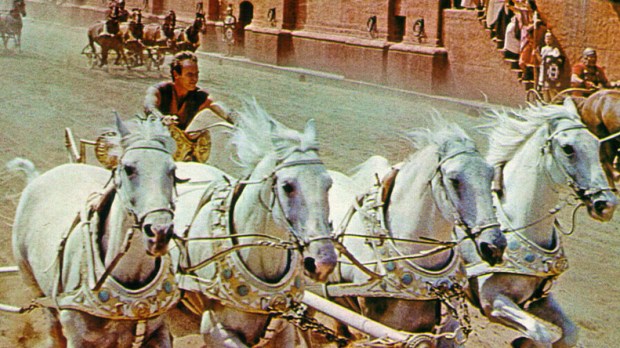William Wyler didn’t want to direct Ben-Hur. He thought it was a simplistic story and wasn’t interested in it. However, Wyler maintained an intense rivalry with Cecil B. DeMille, another of the greats of big Hollywood blockbusters of the time. Wyler felt like one-upping De Mille, who in 1956 had filmed the great biblical epic The Ten Commandments, and it was for this reason that Wyler ended up taking the job.
Charlton Heston wasn’t the first choice. The role was offered first to Burt Lancaster, but he felt that the script didn’t do justice to Christianity; Paul Newman turned it down because he was concerned that his legs wouldn’t look good on screen with him dressed like a Roman. Even so, when Heston joined the shooting Wyler didn’t like at all how he played the part, and it’s said that there were major arguments about the actor’s inability to offer the director what he asked for.
There has always been the myth that there was a homosexual relationship between Messala (Stephen Boyd) and Judah Ben-Hur (Charlton Heston). In reality, this is not true, and Heston himself explicitly denied it. However, it does seem that there was a secret agreement between Wyler and Boyd for Boyd to play Messala with a deeper motivation than mere hatred. Wyler wanted the relationship between the two characters to be especially deep (especially as this is what triggers the plot of the film) and so he asked the actor to make Messala’s admiration and hatred for Ben Hur to go beyond simple friendship. Charlton Heston never knew anything about this.
William Wyler didn’t direct the filming of the famous chariot race. Andrew Marton and Yakima Canutt were responsible for filming that memorable scene. The former was a director who never had great success beyond King Solomon’s Mines and the latter was a seasoned action scene specialist who had specialized in directing the second unit for Hollywood films. Actually, this isn’t unusual. The vast majority of the action scenes in films aren’t shot by their directors, but by those in charge of the second unit.
Record-breaking numbers. Ben-Hur won 11 Oscars, and until the arrival of Titanic it was the film with the greatest number of Oscars in history. Judge for yourselves. For decades it was the most expensive film in history with a budget of more than 15 million dollars. One hundred thousand costumes were used and 300 sets were erected for the occasion. The Roman circus used for the chariot race was built from scratch in full scale, imitating an identical complex in Antioquia. More than 50,000 extras were used — 15,000 for the scenes of the chariot race alone — and the sand in the circus was imported from the beaches of Morocco. It was worth the effort, because it was an instant success.
Ben-Hur is also a remake. In 1925 Fred Niblo filmed the first screen adaptation of Lee Wallace’s novel, on which both films are based. On that film William Wyler worked as an assistant director.
For the galley scene, Metro Goldwyn Mayer had a real ship built. When they put it in the sea, it sank. Then, they built another nearly identical one, but this time they followed the instructions of a naval engineer.
In Ben-Hur all the actors are British or American. The former played the Jews and the latter the Romans.
The shooting of Ben-Hur lasted five years. This is the only Metro Goldwyn Mayer film in which the mythical roar of the studio’s lion mascot is not heard. William Wyler didn’t like the roar of a lion being the first sound heard in his film.
The actor who plays Jesus Christ does not appear in the film credits, and Christ’s face is never seen at any time in the film. The role was played by a respected opera singer, Claude Heater.

